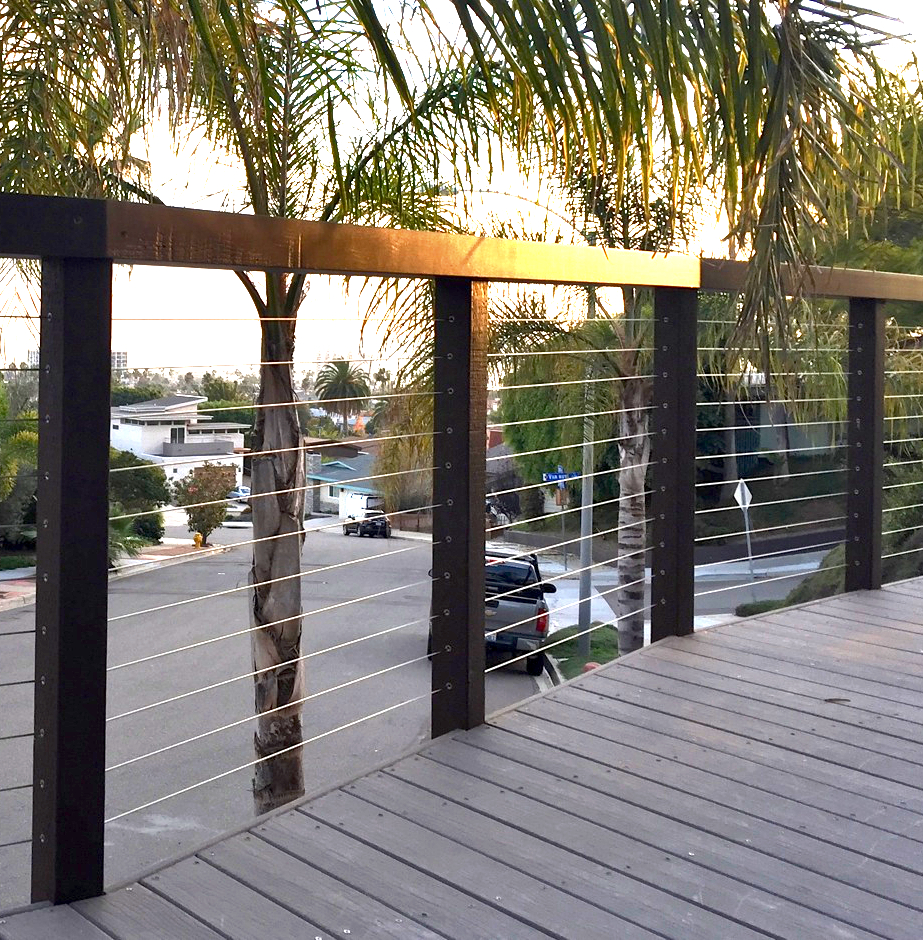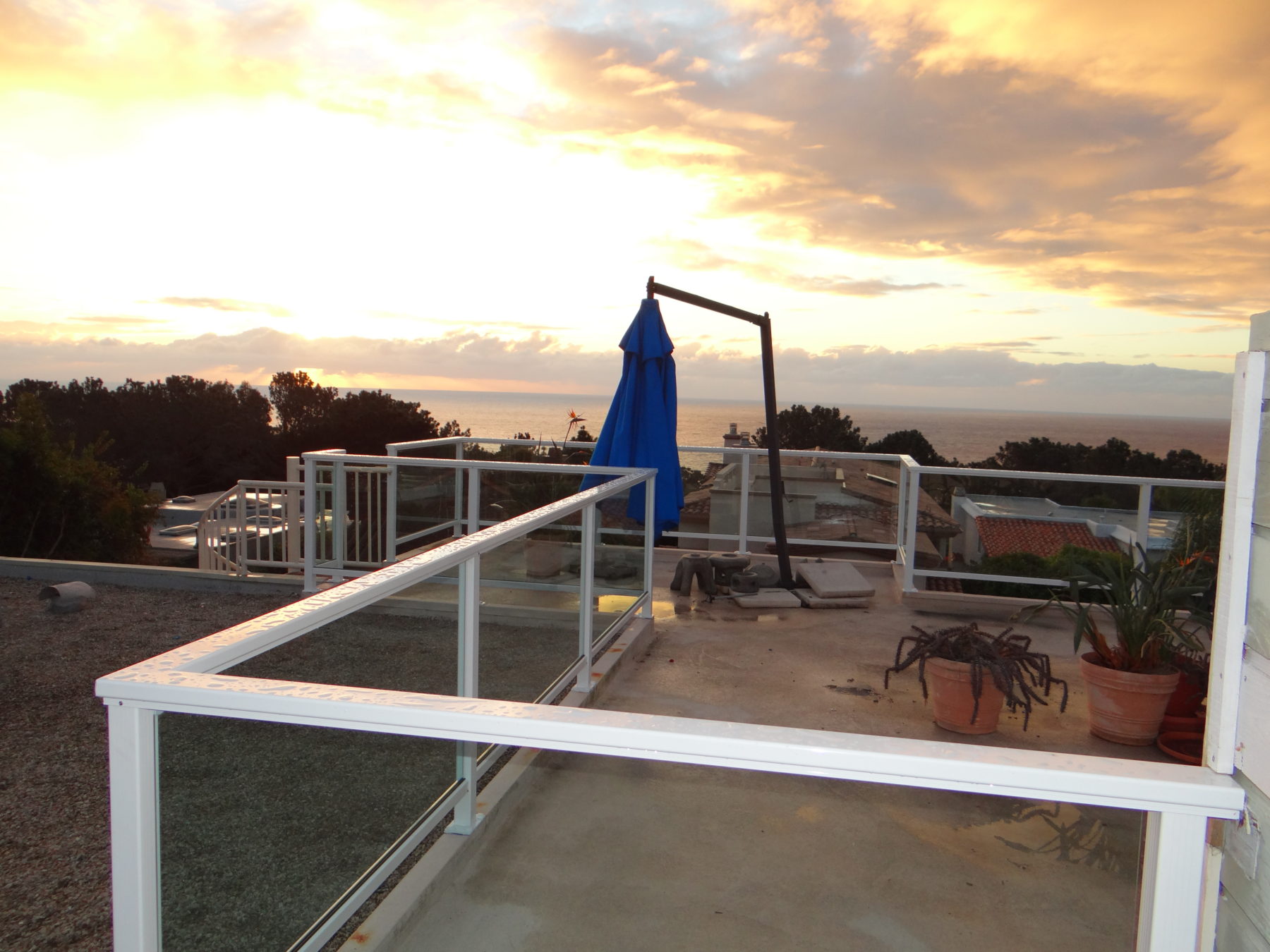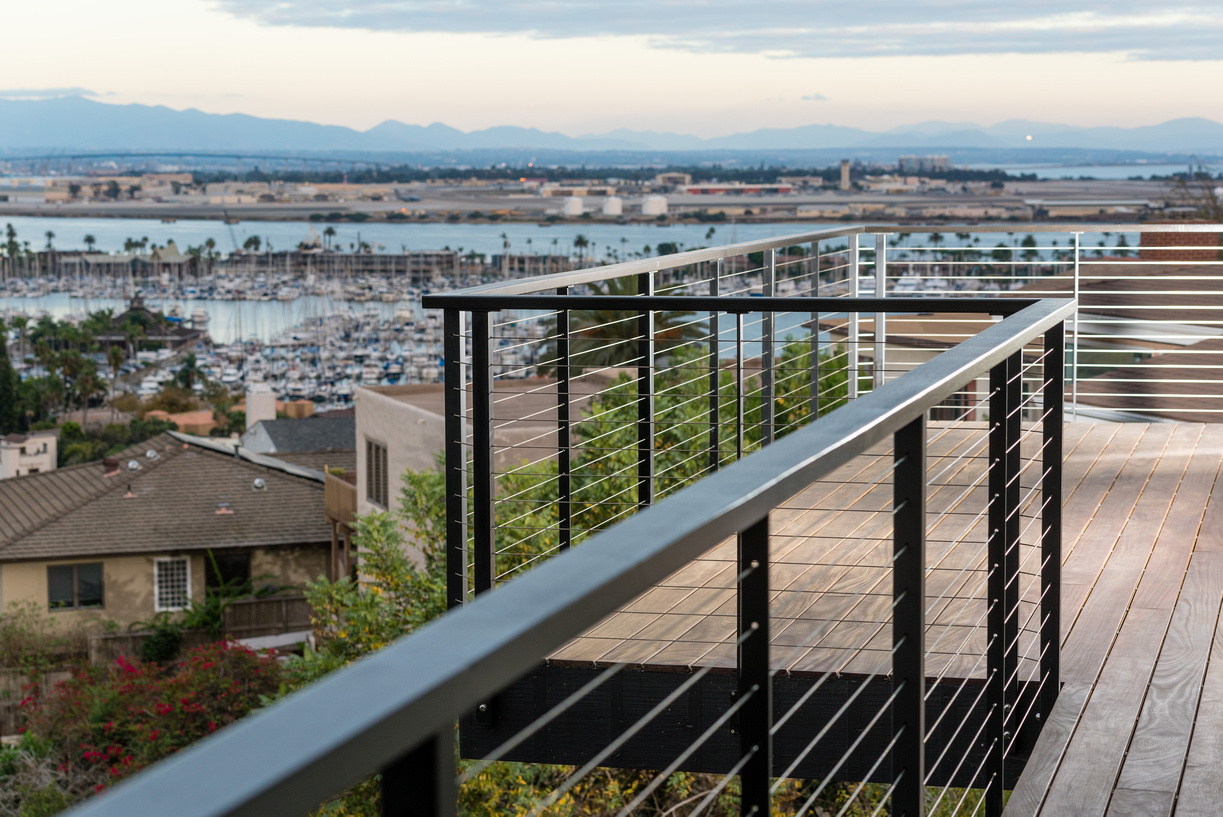




Infill Spacing for Safe Decks Building codes nationwide hold to a 4″ maximum clear spacing requirement for railing infill sections. Whether constructing new or retrofitting older barrier railings the code spacing requirement remains the same. By definition this means that no gap anywhere on the railing should exceed 4″ clear in between members. Older homes, condominiums, and commercial buildings with outdated railings may need to be upgraded in order to satisfy this requirement. Older code spacing (6″-8″) increase liability due to possible falls or injury caused by larger spacing requirements that could allow children through railing members. Newer codes and standards for child safety require tighter gapping. Safer deck railings utilize current codes with sturdy frames and max clear spacing of 4″. Cable rail spacing requires a max 3″ space to allow for deflection. Safer Decks Require Current Codes and Practices The 4″ maximum spacing requirement used for current codes was designed to prevent small children from being able to force their head or body into and through any gaps anywhere on the railing system. Safe railings are all about child safety requirements. In this article we will explore information necessary to upgrade your railing systems and make them safer for children, pets, and people. Railing Heights Vary by State Railing height specifications can vary by state and we recommend checking with current local building codes prior to construction. In California, a minimum railing height of 42″ is required. Other states like Arizona still hold to a 36″ railing height requirement. How to measure for finished railing height? Railing height should be measured from the top of the deck surface to the highest point of the top rail member. When performing site verifications our installers measure from multiple locations across the deck surface. Deck levels can vary, especially when dealing with slopes so it’s best to verify railing height in multiple locations. Vertical and Horizontal Rail Spacing Checking for voids along the railing frame is a good way to make sure your railings meet current codes. Safe deck railings should not contain any gaps larger than 4″. The following are common locations where these voids may occur: –Upright or Vertical Members – check spacing between pickets, posts, and or pipes, also check cables for 3″ spacing compliance –Horizontal railing members– bottom rails should be code spaced from the deck surface. Cable spacing should not exceed 3″ in order to prevent more than 4″ when deflection occurs. Solid members like pipe and/or wooden railing parts that do not deflect can be spaced at 4″ from center of member to member Glass infill – glass panels, lattice or solid wood, steel or other aesthetic panels should not have gaps larger than 4″ in between panels or scrollwork. Hiring Railing Pro to Construct Safer Deck Railings A large number of our customers hire a railing professional to guarantee safety and code compliance. Our preferred installers are licensed contractors; familiar with local and current code requirements. Some custom and higher risk applications like raised decks, balconies, and stairs greatly benefit from using pro’s. Our DIY products and solutions are very popular and easy to install however some applications are better suited for hiring a specialized contractor. HOA’s, and condo complexes are often required to use professional contractors for construction projects. Insurance claims also require the use of a professional. Large scale industrial projects, commercial, and retail spaces are best handled by licensed professionals. Our team at San Diego Cable Railings has been fabricating and installing code compliant railings since 2009. If you are interested in learning more please give us a call or visit the quote request page to receive an estimate. CLICK HERE TO SUBMIT A QUOTE REQUEST Cable Railing News Stair Railing Ideas MavenSeptember 6, 2024 Safe Deck Railings Pony Wall Railing Renovations MavenAugust 20, 2024 kids and cable railings, Safe Deck Railings Safer Deck Railings MavenJuly 31, 2024 deck railing costs Deck Railing Costs MavenJuly 16, 2024 glass railing posts All Purpose Railing Posts MavenJune 30, 2024 Browse More Posts

Rooftop decks showcase panoramic views and enhance outdoor living spaces. They add ambiance to our homes and provide opportunities to dine outside. Many times a rooftop veranda will expose views not previously available from inside the home. The extreme heights above grade that enable the spectacular views do require additional safety considerations. When dealing with rooftop deck safety, our concern is often largely geared towards the barrier railings. Barrier railing installations on roof decks pose a different set of considerations than ground level decks. In this article we will discuss some of these considerations and ways to mitigate any potential safety issues. Safest Railings for Raised Decks Whether you choose a traditional picket railing, glass panels, or one of the many other options available; a rooftop railing installation will be unique. Rooftop decks are almost always sloped and sloped deck railings require some custom considerations. So what are the most important things to consider when it comes to constructing rooftop deck railings? How should you mount your railings to a rooftop? Here are some common safety considerations for rooftop decks: Slopes and Transitions- Almost all roof decks are pitched in one or multiple directions. The ability to shed water is what basically defines a dry deck space. The amount of slope the deck requires will depend on the design parameters and the size of the deck. Some rooftop decks on flat roofs utilize drains or scuppers to direct water. In comparison; ground level decks are typically built level, which can be a much easier railing installation. Rooftop deck railings often require the installer to adjust for slope and angles. Choosing to construct a sloped railing vs. a level railing is often overlooked. It can make all the difference in the finished product. Although a sloped railing is a possibility or even necessity in some cases, the level rail option is almost always preferred over a sloped railing. In our experience the sight line usually starts high and moves downward, meaning the top rail will catch the first glance almost 100% of the time. What Can Be Done About Perforations? Rooftop deck safety also includes waterproofing. In most cases, waterproofing should be completed and cured prior to the railing installation. Unless the post bases are to be coated over during waterproofing; it is preferable to install them on a finished surface. Additionally, products like Jiffy Seal and other flashing options can be used under railing posts to protect waterproof membranes. Sealing around post bases and annual safety inspections can also be very beneficial. Structural Considerations for Safe Deck Railings- The safest deck railings are attached extremely well and protect persons and pets from falls. Attachment needs to be done by utilizing connections to structural members. Bolting into plywood sheeting alone is not acceptable, even if a deck is already constructed. Whether you are building a new deck or repairing an old deck, it’s important to add blocking at the post locations prior to waterproofing. A professional railing installer or contractor should be able to locate structural members and or isolate any issues with attachment prior to construction. Solid blocking or structural members must offer at least 3″ of embedment for bolts attaching railing frames. If you have questions about rooftop deck safety or would like an estimate for a deck railing give our pros a call at 844-277-7327 or visit the quote request page.

If you’re building a raised deck it’s important to understand the basic safety and loading requirements for standard construction. Thousands of people are injured annually due to deck and porch accidents. Structural instability is almost always the cause for these deck failures and for this reason we offer our customers the following info. Understanding live loads, lateral loads and post spacing requirements can be a great asset to any deck building project. Live loading requirements are commonly referenced when discussing the amount of weight a deck must be able to safely carry. A common requirement for today’s decks is 60 psf. The PSF abbreviation refers to “pounds per square foot.” Simple calculations can be performed in order to calculate the live load requirements for your deck, based on span tables like the one shown below: Code Requirements for Decking Loads A pounds per square foot calculation at 60 psf. will provide a safety factor for any raised platform that can safely accommodate the weight of persons and furniture on the deck surface. A well built deck should always lean towards “over built” for additional loading, snow loads etc. In many cases, a 2 to 1 safety factor is the safest approach. Simply stated a 60 pound per square foot floor load should already contain this safety factor. As these requirements can vary by area; it’s always best practice to check local codes. The code height requirement for deck railings in California is 42″ finished height from the top of the decking to the top of the railing. Any openings in the infill must prevent a 4″ sphere from passing through the railing. A 36″ railing height is required for stairs with graspable railings required in many cases. Customers purchasing pre made railing posts should consider that the finished post height allows for a solid connection that will withstand a 200 pound lateral load applied to posts or railing sections in any direction. Deck Safety Requirements for Railing Posts Post spacing will greatly influence the overall strength and loading ability of a deck railing. Call outs for railing post installations that exceed 6′ spacing will not likely pass a building inspection. For cable railing systems a max spacing of 4′ on center will commonly be required to ensure that 3″ cable spacing can carry sufficient tension to pass a 4″ sphere test. For glass railings a max post spacing of 5′ is often recommended. Many online retailers call for up to 8′ spacing for deck railings however our preferred contractors do not recommend this for any raised deck surface. Choosing the Sturdiest Decking and Railing Products Customers looking for high strength and durability will find that only top quality materials can provide the best finished product for passing inspections. Hardwood decking planks like Ipe’ and Cumaru offer the same span capabilities at 1″ thickness that other wood types call for 1.5″ thickness. Durability of hardwood products is also likely at least double that of popular soft wood choices. In some cases hardwood is 30 times more dense than standard framing lumber. Composite decking planks like Trex are a low maintenance option for exterior decks; with some warranties lasting 25 years. Customers selecting composite products should however consider the fact that these products are not structural in nature; and that framing requirements may need to be more stringent for composite decking. Joist spans may need to be tightened in order to maintain stability. When selecting a railing for ultimate strength; steel posts and rails will almost always offer more strength than wood by comparison. Only hardwood species can come close to steel in terms of strength and hardness. In addition, the longevity and wear resistance provided by steel and stainless steel railings is also much higher than wood. San Diego Cable Railings is dedicated to the production of high quality stainless steel railing systems. Our company sells a full line of cable and glass railings, as well as engineered railing posts for a variety of applications. If you have questions about deck safety requirements on your project; or you would like an estimate for deck railings click the link below.